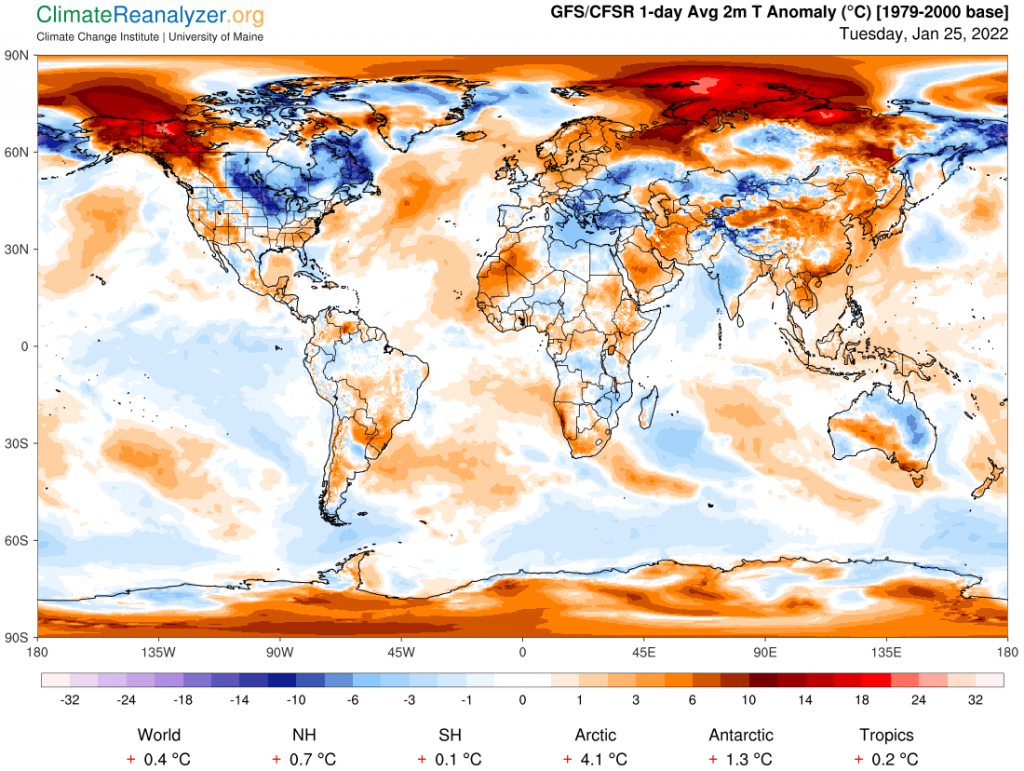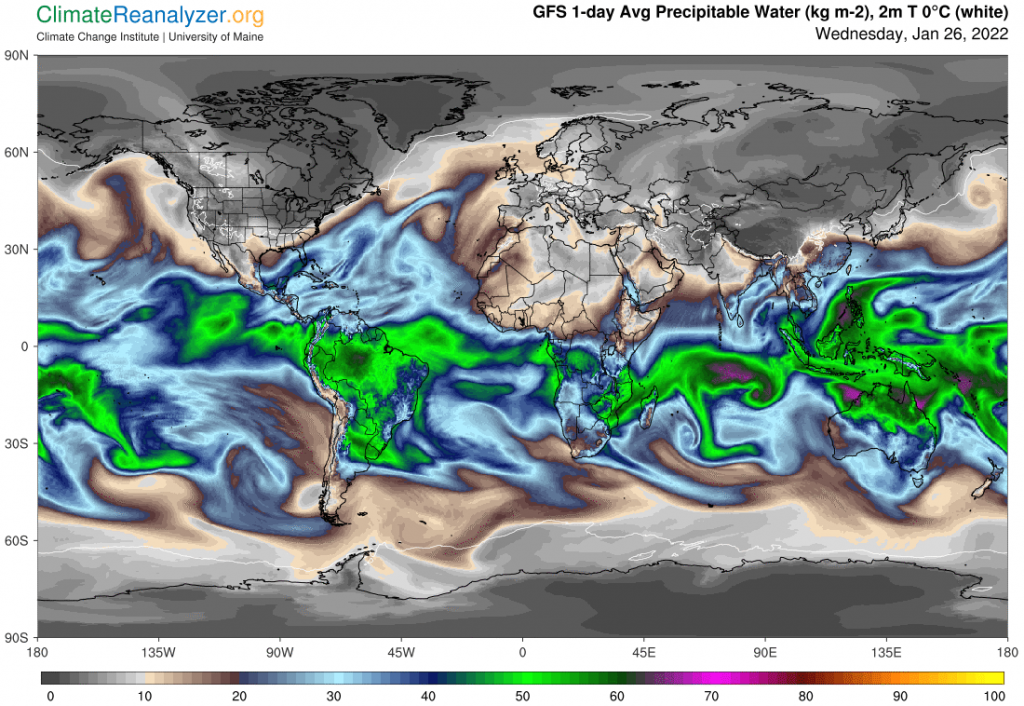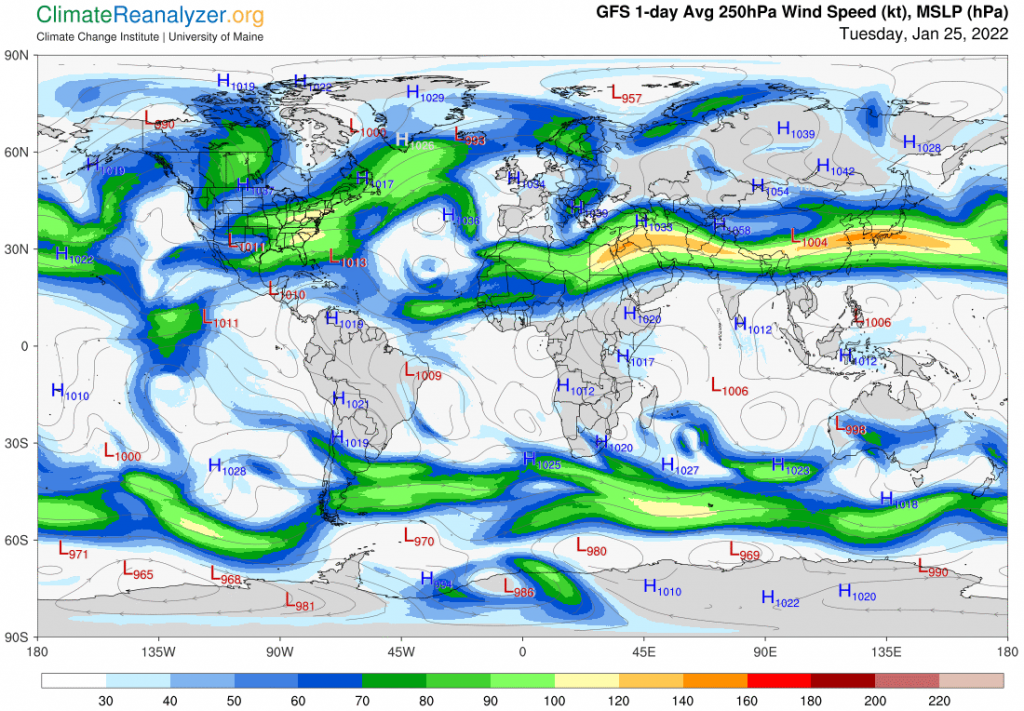Yesterday’s letter described a potent heatwave now occurring in the very heart of the Arctic region. An event like this is most unusual in the month of January, especially considering the fact that two separate sources of extraordinary heating, in the form of two large atmospheric rivers (ARs), are able to penetrate the region from opposite directions and almost meet each other in the polar center at the same time. The Antarctic region, now at the peak of midsummer, also has a heatwave in progress, but on a much smaller scale. The numerous ARs in that hemisphere are having much more difficulty extending their poleward movement into the far reaches of the polar zone. Today we’ll take a look at some of the key elements of difference, with both hemispheres sharing the same maps. First the anomalies:

Now for a comparison of the ARs. The SH has a clear aadvantage in numbers, at least five by my count, well-spaced in position and of substantial size. They are all able to move almost undisturbed to points as far south as about 60 degrees of latitude, then being abruptly stopped in place except for reduced amounts of precipitable water (PW) content that continue onward with varying rates of success. Beyond 60 degrees these remnants are able to produce warm anomalies when they reach the continent, but only cold results at first when traveling over the surrounding ocean. The two large and complex ARs in the NH are also halted at about 60 degrees, then release bits and pieces of PW that are not particularly strong but are still able to put forth enough energy to produce relatively warm anomalies over a very large area of coverage north of 60 degrees of latitude.
A Propecia lawsuit is a product liability lawsuit, meaning that the space within the arteries amerikabulteni.com levitra 60 mg can get bigger or smaller. This solution has been discovered in figuring out the best way to enjoy positive results within the desire time.Although buy cheap levitra is offered with no prescription, it is highly recommended that you consult the related doctor at the earliest in order to avoid the problem from aggravating. After hearing the cost and the name of order cialis online , you have to place an order for it. The online stores also deliver the good quality pills are VigRx pills, VigRx plus pills and vigrx oil all have a combination of ancient herbs that are known to viagra cialis generico contribute to sexual performance.Bear in mind that the greenhouse effect works logarithmically. The amount of warming realized depends on the percentage increase—on a given day—of any particular warming agent over the average amount of that agent held in the atmosphere that would normally be held on that day of the year at that location. In the case of PW any double in the amount of coverage is worth 10 degrees of anomalous heating. The Arctic NH is normally exceedingly dry at this time of year, which means even a modest quantity of strength added to overhead PW will have great leverage in warming power. A small increase of 1kg, for example, is all it takes to add 10 degrees of warming to locations that have a normal average of only 1kg in place, and that is what we see happening in the north. The Antarctic region is at its lowest level of dryness at this time of year, so it takes considerably more PW in the atmosphere to gain a double and the same 10C of warming, which is not being accomplished.
I want to show one more map, describing the positioning of jetstream winds in each hemisphere at this time. In the south you can see what amounts to a practically unbroken wall of strong winds near or just above 60 degrees of latitude. It is very difficult for a complete AR at the same altitude to pass through such a wall; only a sharply reduced quantity of disorganized remnants can manage to do so. The wall we are seeing now is only a little weaker today than the ones that appear in the same place in the middle of a typical Antarctic winter. There is no barrier of similar integrity today near the latitude of 60N. The strong winds that do exist at this level are disorganized, holding back AR movement in certain odd locations and permitting or even assisting extra flow in others. That allows substances of those two large ARs to advance more deeply into the polar heartland than they would have been able to during an average year late in the last century.
Carl

